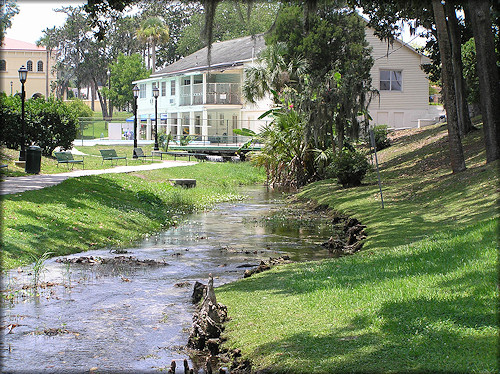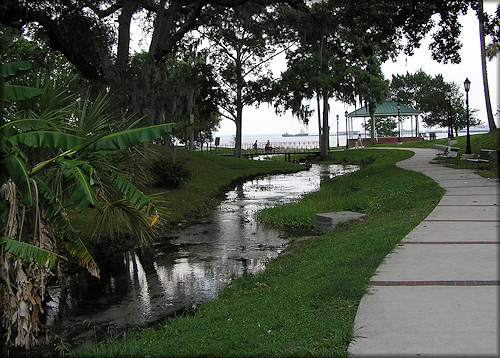|
Following the trail of Dr. Fred Thompson to historic Green Cove Springs, Florida |
|
| On June
12, 1975, Dr. Fred Thompson, malacologist at the Florida Museum of
Natural History in Gainesville, Florida collected Pomacea paludosa (Florida Apple
Snail) from a spring in a city park in downtown Green Cove Springs
in Clay County, Florida. Fred's specimen(s) was subsequently
integrated into the museum's holdings and assigned catalog number
UF22481. While doing research on the species presence in northeast Florida, this investigator's eye was caught by Fred's record. Subsequent research using the Internet indicated that the spring visited by Fred in 1975 was indeed a very unusual habitat for apple snails and a historic one as well. The spring is one of approximately a dozen sulfur water springs in Florida and the water boils up from a large fissure, some twenty feet below the surface, at the rate of approximately 3,000 gallons per minute. The 78-degree spring feeds the immediately adjacent municipal pool and then flows down "Spring Run" for approximately 100 yards before entering the brackish St. Johns River. In essence, the populations available habitat consists only of a spring run some 300 feet long and about 20 feet wide at its widest point. Around 1850, Green Cove became a prime tourist attraction, famous for the warm, therapeutic springs. The sulfur springs, or the “boil” as it was called, brought wealthy visitors down the St. Johns River by steamboat to vacation at the grand hotels like the Clarendon and Qui-Si-Sana. Visitors of the period included Henry Flagler and his new bride, the Astors and Vanderbilts. The visitors drank from the spring believing in its medicinal values. It is said one local physician prescribed the spring water for various chronic ailments of the liver and kidneys. There are those today that still have confidence in the therapeutic value of the springs and can be seen daily drawing water from the spring for consumption. My curiosity aroused, I wondered whether the snails were still present in this very exposed and modest habitat thirty-three years after Fred's collecting trip. On June 17, 2008 a trip was made to Green Cove Springs to satisfy this curiosity. Upon my arrival at the park it was immediately obvious that not only were the snails still present, but they were thriving. Pomacea egg clutches were present in large numbers on vegetation both in and alongside the spring run from near the upper end, where it drained from the municipal pool, to where it met the brackish river water. Although not a large number of living Pomacea were seen, it was obvious from the egg clutches that the population was respectable. This is the first time that this investigator has observed P. paludosa egg clutches festooning both a palm and banana tree. The sulfur water appeared to have no effect on the Pomacea in regards to shell size and coloration but Vitta usnea (Röding, 1798) [Olive Nerite], also present in the spring run, were large and misshapen. While Pomacea paludosa have been found in northeast Florida in much more modest habitats, none can compare with the beauty and history offered by the unique Green Cove Springs location. |
|
|
View of the spring run looking toward the municipal swimming pool |
|
|
|
|
|
View of the spring run looking towards the St. Johns River |
|
|
|
|

